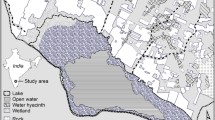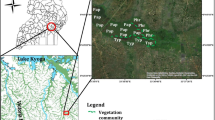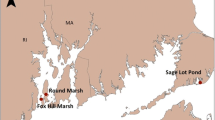Abstract
Water hyacinth is able to sequester large amounts of carbon dioxide (CO2) in wetlands. At the same time, the high production of organic matter combined with the plant’s capacity to limit the diffusion of oxygen from the atmosphere into the water creates favorable conditions for the production of methane (CH4). The combination of these mechanisms challenges the prediction of water hyacinth’s net effects on greenhouse gas (GHG) emissions. To unravel the impact of water hyacinth on GHG fluxes, we performed an extensive fieldwork study encompassing 22 sites dominated by water hyacinth in the Pantanal and Amazon during two different seasons. The highest CH4 emissions from water hyacinth beds occurred in shallow systems where sediment rooting enabled plant-mediated CH4 transport (307 ± 407 mg CH4 m−2 day−1 in waters shallower than 1 m, as opposed to 6.1 ± 10.6 mg CH4 m−2 day−1 in deeper waters). When CO2 uptake rates are added to the GHG budget (in terms of global warming potential), the water bodies were usually a GHG sink (− 5.2 ± 10 gCO2 eq m−2 day−1). The strength of the sink is highest in deeper systems where even a low water hyacinth coverage may already offset open water emissions. This dual effect of strong CO2 uptake—and at least temporal carbon storage in biomass—in combination with a high CO2–to-biomass-to-CH4 (and possibly back to CO2) conversion highlights the necessity to include vegetation characteristics in relation to depth when estimating GHG fluxes for tropical wetlands.








Similar content being viewed by others
References
Aben RCH, Barros N, van Donk E, Frenken T, Hilt S, Kazanjian G, Lamers LPM, Peeters E, Roelofs JGM, de Senerpont Domis LN, Stephan S, Velthuis M, Van de Waal DB, Wik M, Thornton BF, Wilkinson J, DelSontro T, Kosten S. 2017. Cross continental increase in methane ebullition under climate change. Nature Communications 8:1682.
Abril G, Martinez JM, Artigas LF, Moreira-Turcq P, Benedetti MF, Vidal L, Meziane T, Kim JH, Bernardes MC, Savoye N, Deborde J, Souza EL, Alberic P, Landim de Souza MF, Roland F. 2014. Amazon River carbon dioxide outgassing fuelled by wetlands. Nature 505:395–8.
Almeida RM, Nobrega GN, Junger PC, Figueiredo AV, Andrade AS, de Moura CG, Tonetta D, Oliveira-Junior ES, Araujo F, Rust F, Pineiro-Guerra JM, Mendonca JR Jr, Medeiros LR, Pinheiro L, Miranda M, Costa MR, Melo ML, Nobre RL, Benevides T, Roland F, de Klein J, Barros NO, Mendonca R, Becker V, Huszar VL, Kosten S. 2016. High primary production contrasts with intense carbon emission in a eutrophic tropical reservoir. Frontiers in Microbiology 7:717.
Attermeyer K, Flury S, Jayakumar R, Fiener P, Steger K, Arya V, Wilken F, van Geldern R, Premke K. 2016. Invasive floating macrophytes reduce greenhouse gas emissions from a small tropical lake. Scientific Reports 6:20424.
Ávila MP, Oliveira-Junior ES, Reis MP, Hester ER, Diamantino C, Veraart AJ, Lamers LPM, Kosten S, Nascimento AMA. 2019. The water hyacinth microbiome: link between carbon turnover and nutrient cycling. Microbial Ecology 78:575–88.
Banik A, Sen M, Sen SP. 1993. Methane emissions from water hyacinth-infested freshwater ecosystems. Chemosphere 27:1539–52.
Barbiero L, Siqueira Neto M, Braz RR, do Carmo JB, Rezende Filho AT, Mazzi E, Fernandes FA, Damatto SR, de Camargo PB. 2018. Biogeochemical diversity, O2 -supersaturation and hot moments of GHG emissions from shallow alkaline lakes in the Pantanal of Nhecolândia, Brazil. Science of The Total Environment 619–620:1420–30.
Bastviken D, Cole JJ, Pace ML, Van de Bogert MC. 2008. Fates of methane from different lake habitats: connecting whole-lake budgets and CH4 emissions. Journal of Geophysical Research: Biogeosciences 113:G02024.
Bastviken D, Santoro AL, Marotta Humberto, Pinho Luana Queiroz, Calheiros Debora Fernandes, Crill P, Enrich-Prast A. 2010. Methane emissions from Pantanal, South America, during the low water season: toward more comprehensive sampling. Environmetal Science & Technology 44:5450–5.
Bolpagni R, Pierobon E, Longhi D, Nizzoli D, Bartoli M, Tomaselli M, Viaroli P. 2007. Diurnal exchanges of CO2 and CH4 across the water–atmosphere interface in a water chestnut meadow (Trapa natans L.). Aquatic Botany 87:43–8.
Brix H, Sorrell BK, Lorenzen B. 2001. Are Phragmites-dominated wetlands a net source or net sink of greenhouse gases? Aquatic Botany 69:313–24.
Bunch AJ, Allen MS, Gwinn DC. 2010. Spatial and temporal hypoxia dynamics in dense emergent macrophytes in a Florida Lake. Wetlands 30:429–35.
Carmichael MJ, Bernhardt ES, Bräuer SL, Smith WK. 2014. The role of vegetation in methane flux to the atmosphere: should vegetation be included as a distinct category in the global methane budget? Biogeochemistry 119:1–24.
Carvalho FT, Galo MLBT, Velini ED, Martins D. 2003. Plantas aquáticas e nível de infestação das espécies presentes no reservatório de barra bonita, no rio tietê. Planta Daninha 21:15–19.
Cavenaghi AL, Velini ED, Negrisoli E, Carvalho FT, Trindade MLB, Corrêa MR, Galo MLBT, Santos SCA. 2005. Monitoramento de problemas com plantas aquáticas e caracterização da qualidade de água e sedimento na UHE Mogi-Guaçu. Planta Daninha 23:225–31.
Chaves OR, Arruda EFd. 2011. História e Memória: Cáceres. Cáceres: UNEMAT. 303p.
Coelho CAS, Cardoso DHF, Firpo MAF. 2015. Precipitation diagnostics of an exceptionally dry event in São Paulo. Brazil. Theoretical and Applied Climatology 125(3–4):769–84.
Devol AH, Forsberg BR, Richey JE, Pimentel TP. 1995. Seasonal variation in chemical distributions in the Amazon (Solimões) River: a multiyear time series. Global Biogeochemical Cycle 9:307–28.
Devol AH, Richey JE, Forsberg BR, Martinelly LA. 1990. Seasonal dynamics in methane emissions from the amazon river floodplain to the troposphere. Journal of Geophysical Research: Biogeosciences 95:417–26.
Ding W, Cai Z, Tsuruta H. 2005. Plant species effects on methane emissions from freshwater marshes. Atmospheric Environment 39:3199–207.
Dorodnikov M, Knorr KH, Kuzyakov Y, Wilmking M. 2011. Plant-mediated CH4 transport and contribution of photosynthates to methanogenesis at a boreal mire: a 14C pulse-labeling study. Biogeosciences 8:2365–75.
Franca RRd. 2015. Climatologia das chuvas em Rondônia – período 1981-2011. Geografias Artigos Científicos 11.
Grasset C, Abril G, Guillard L, Delolme C, Bornette G. 2016. Carbon emission along a eutrophication gradient in temperate riverine wetlands: effect of primary productivity and plant community composition. Freshwater Biology 61:1405–20.
Gripp AdR, Marinho CC, Sanches LF, Petruzzella A, Esteves FdA. 2013. The role played by aquatic macrophytes regarding CO2 balance in a tropical coastal lagoon (Cabiúnas Lagoon, Macaé, RJ). Acta Limnologica Brasiliensia 25:291–301.
Hamilton SK, Sippel SJ, Calheiros DF, Melack JM. 1997. An anoxic event and other biogeochemical effects of the Pantanal wetland on the Paraguay river. Limnology and Oceanography 42:257–72.
Hamilton SK, Sippel SJ, Melack JM. 1995. Oxygen depletion and carbon dioxide and methane production in waters of the pantanal wetland of Brazil. Biogeochemistry 30:115–41.
Heiri O, Lotter AF, Lemcke G. 2001. Loss on ignition as a method for estimating organic and carbonate content in sediments: reproducibility and comparability of results. Journal of Paleolimnology 25:101–10.
Junk WJ, Piedade MT, Lourival R, Wittmann FD, Kandus P, Lacerda LD, Bozelli RL, Esteves FA,, da Cunha CN, Maltchik L, Schöngart J, Schaeffer-Novelli Y, and Agostinho AA. 2014. Brazilian wetlands: their definition, delineation, and classification for research, sustainable management, and protection. Aquatic Conservation: Marine and Freshwater Ecosystems, 24(1): 5–22.
Keppler F, Hamilton JT, Brass M, Rockmann T. 2006. Methane emissions from terrestrial plants under aerobic conditions. Nature 439:187–91.
Kosten S, Piñeiro M, de Goede E, de Klein J, Lamers LP, Ettwig K. 2016. Fate of methane in aquatic systems dominated by free-floating plants. Water Research 104:200–7.
Kosten S, van den Berg S, Mendonça R, Paranaíba JR, Roland F, Sobek S, Van Den Hoek J, Barros N. 2018. Extreme drought boosts CO2 and CH4 emissions from reservoir drawdown areas. Inland waters 8:329.
Machado DO, Alves-Sobrinho T, Ribeiro AdS, Ide CN, Oliveira PTS. 2014. Erosividade da chuva para o bioma Pantanal. Engenharia Sanitaria e Ambiental 19:195–201.
Marani L, Alvala P. 2007. Methane emissions from lakes and floodplains in Pantanal, Brazil. Atmospheric Environment 41:1627–33.
Masifwa WF, Twongo T, Denny P. 2001. The impact of water hyacinth, Eichhornia crassipes Mart Solms on the abundance and diversity. Hydrobiologia 452:79–88.
Melack JM, Hess LL, Gastil M, Forsberg BR, Hamilton SK, Lima IBT, Novo EMLM. 2004. Regionalization of methane emissions in the Amazon Basin with microwave remote sensing. Global Change Biology 10(5):530–44.
Mendonça R, Kosten S, Sobek S, Cole JJ, Bastos AC, Albuquerque AL, Cardoso SJ, Roland F. 2014. Carbon Sequestration in a Large Hydroelectric Reservoir An Integrative Seismic Approach. Ecosystems: 430–441.
Mironga JM, Mathooko JM, Onywere SM. 2011. The Effect of Water Hyacinth (Eichhornia Crassipes) Infestation on Phytoplankton Productivity in Lake Naivasha and the Status of Control. Journal of Environmental Science and Engineering 5:1252–60.
Myhre G, Shindell D, Bréon F-M, Collins W, Fuglestvedt J, Huang J, Koch D, Lamarque J-F, Lee D, Mendoza B, Nakajima T, Robock A, Stephens G, Takemura T, Zhang H. 2013. Anthropogenic and Natural Radiative Forcing. [Stocker TF, D. Qin, G.-K. Plattner, M. Tignor, S.K. Allen, J. Boschung, A. Nauels, Y. Xia, V. Bex and P.M. Midgley editor. Climate Change 2013: The Physical Science Basis. Contribution of Working Group I to the Fifth Assessment Report of the Intergovernmental Panel on Climate Change. Cambridge, United Kingdom and New York, NY, USA: Cambridge University Press.
Nyananyo BL, Gijo AH, Ogamba EN. 2007. The physico-chemistry and distribution of water hyacinth (Eichhornia crassipes) on the river Nun in the Niger Nelta. Applied Sciences Environmental Management 11:133–7.
Oliveira-Junior ES, Tang Y, van den Berg SJ, Cardoso SJ, Lamers LP, Kosten S. 2018. The impact of water hyacinth (Eichhornia crassipes) on greenhouse gas emission and nutrient mobilization depends on rooting and plant coverage. Aquatic Botany 145:1–9.
Oo AZ, Sudo S, Inubushi K, Mano M, Yamamoto A, Ono K, Osawa T, Hayashida S, Patra PK, Terao Y, Elayakumar P, Vanitha K, Umamageswari C, Jothimani P, Ravi V. 2018. Methane and nitrous oxide emissions from conventional and modified rice cultivation systems in South India. Agriculture, Ecosystems & Environment 252:148–58.
Owens CS, Madsen AJD. 1995. Low temperature limits of waterhyacinth.pdf. Aquatic Plant Management 33:63–8.
Pangala SR, Enrich-Prast A, Basso LS, Peixoto RB, Bastviken D, Hornibrook ER, Gatti LV, Marotta H, Calazans LSB, Sakuragui CM. 2017. Large emissions from floodplain trees close the Amazon methane budget. Nature 552:230.
Paranaíba JR, Quadra G, Josué IIP, Almeida RM, Mendonça R, Cardoso SJ, Silva J, Kosten S, Campos JM, Almeida J, Araújo RL, Roland F, Barros N. 2020. Sediment drying-rewetting cycles enhance greenhouse gas emissions, nutrient and trace element release, and promote water cytogenotoxicity. PLoS ONE 15(4):e0231082.
Peixoto RB, Marotta H, Bastviken D, Enrich-Prast A. 2016. Floating aquatic macrophytes can substantially offset open water CO2 emissions from tropical floodplain lake ecosystems. Ecosystems 19:724–36.
Penfound T, Earle TT. 1948. The biology of the water hyacinth. Ecological Monographs 18:447–72.
Reddy KR, DeBusk WF. 1991. Decomposition of water hyacinth detritus in eutrophic lake water. Hydrobiologia 211:101–9.
Ren MX, Zhang QG. 2007. Clonal diversity and structure of the invasive aquatic plant Eichhornia crassipes in China. Aquatic Botany 87:242–6.
Téllez TR, López E, Granado G, Pérez E, López R, Guzmán J. 2008. The Water Hyacinth, Eichhornia crassipes: an invasive plant in the Guadiana River Basin (Spain). Aquatic Invasions 3:42–53.
Villamagna AM, Murphy BR. 2010. Ecological and socio-economic impacts of invasive water hyacinth (Eichhornia crassipes): a review. Freshwater Biology 55:282–98.
Whiting GJ, Chanton JP. 1992. Plant-dependent CH4 emission in a subarctic canadian fen. Global Biogeochemical Cycles 6:225–31.
Yoshida N, Iguchi H, Yurimoto H, Murakami A, Sakai Y. 2014. Aquatic plant surface as a niche for methanotrophs. Frontiers in Microbiology 5:1–9.
Zampin IC, Ribeiro SL, Martini CJ. 2017. Aguapé (Eichhornia crassipes) no Ribeirão Claro em Rio Claro - SP, antes e depois da implantação da ETE conduta: uma proposta para educação ambiental. Revista Gestão Universitária 7:1–19.
Acknowledgements
The authors would like to thank the institutions that helped during the field campaign—6o Batalhão de Fronteira de Cáceres; Grupo Cassol Energia; Bichos do Pantanal Project through the Socio-environmental Petrobras Program; and the Federal University of Juiz de Fora—Brazil. We thank Donato Abe for borrowing the Uwitec corer sampler. Also, we thank the people involved in the laboratory analyses (Roy Peters; Germa Verheggen; Sebastian Krosse; Paul van der Ven). Finally, we would like to thank the institutions funding this research - Koninklijke Nederlandse Akademie van Wetenschappen (KNAW-Ecology Fund) and Fundação de Amparo a Pesquisa de Mato Grosso (FAPEMAT). E.S. was also funded by the Coordenação de Aperfeiçoamento de Pessoal de Nível Superior—CAPES by the Science without Borders program Process BEX 13607/13-8. S.K. was supported by NWO-VENI grant 86312012.
Author information
Authors and Affiliations
Corresponding author
Additional information
Author contributions
ESOJ and SK designed the research. ESOJ, SK, TB, JN, AB, RA, SW collected the data, analyzed the material sampled in the laboratory and analyzed the results. CA, CM, JR, and LL discussed the results. ESOJ wrote the manuscript and all other authors provided discussions of the content and editorial advice.
Electronic supplementary material
Below is the link to the electronic supplementary material.
Rights and permissions
About this article
Cite this article
Oliveira Junior, E.S., van Bergen, T.J.H.M., Nauta, J. et al. Water Hyacinth’s Effect on Greenhouse Gas Fluxes: A Field Study in a Wide Variety of Tropical Water Bodies. Ecosystems 24, 988–1004 (2021). https://doi.org/10.1007/s10021-020-00564-x
Received:
Accepted:
Published:
Issue Date:
DOI: https://doi.org/10.1007/s10021-020-00564-x




